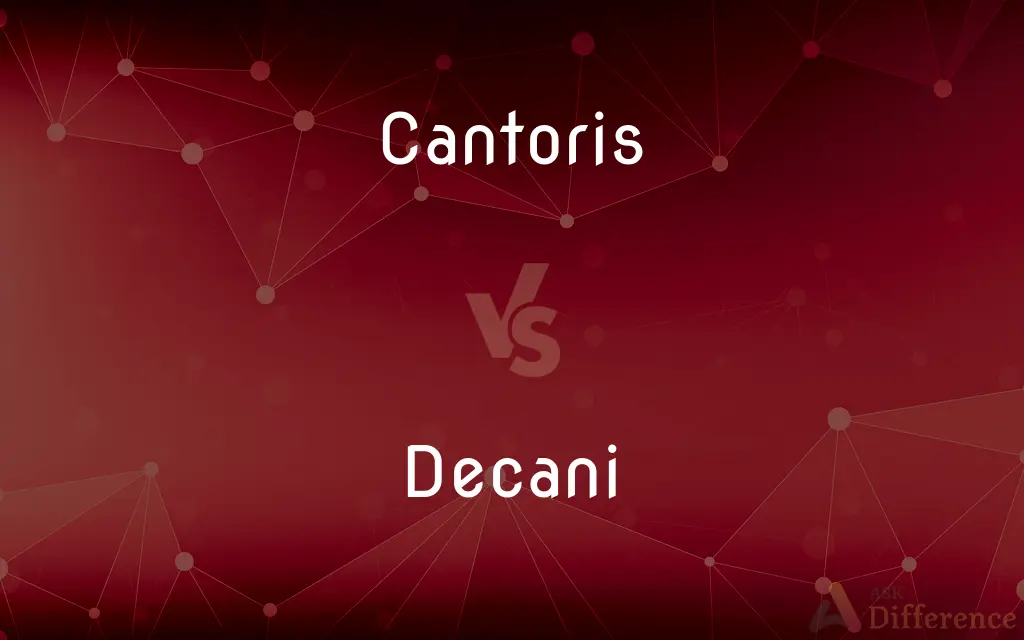Cantoris vs. Decani — What's the Difference?
Edited by Tayyaba Rehman — By Fiza Rafique — Updated on April 1, 2024
Cantoris refers to the choir section on the north side of a choir, often associated with the cantor, while Decani denotes the south side, linked with the dean's position.

Difference Between Cantoris and Decani
Table of Contents
ADVERTISEMENT
Key Differences
Cantoris is a term used in choral music to identify the section of a choir situated on the north side of the chancel, traditionally where the cantor, a lead singer or conductor of the choir, might stand. This positioning has historical and liturgical significance, emphasizing the role of the cantor in leading psalms or chants. On the other hand, Decani refers to the choir section on the south side of the chancel, historically associated with the dean of the cathedral or church. This distinction underlines the dean's authority and their liturgical role in the service.
The concept of Cantoris and Decani stems from the layout of Christian cathedrals and churches, particularly in Anglican and Roman Catholic traditions. This division not only serves a functional purpose in organizing choir members but also symbolizes the dual leadership within the church's musical and clerical hierarchy. Whereas the Cantoris side emphasizes the musical and instructional aspects of worship, the Decani side represents administrative and pastoral leadership.
In terms of acoustics and performance, choirs often utilize the spatial separation of Cantoris and Decani to achieve a stereophonic effect in antiphonal music, where two sections of the choir respond to each other. This arrangement enhances the worship experience, creating a call-and-response pattern that enriches the liturgy. Conversely, the Decani side, mirroring the Cantoris, contributes to this auditory experience, ensuring a balanced and immersive sound that encompasses the congregation.
Traditionally, choirs are divided into four sections: soprano, alto, tenor, and bass. In many choral settings, these sections are split between the Cantoris and Decani sides to balance the choir's overall sound. While the Cantoris side may house certain voice types to leverage the acoustics of the north side of the chancel, the Decani side similarly positions its singers to optimize sound on the south side, reflecting a strategic use of space for musical depth and richness.
In the broader context of church services and liturgical practices, the distinction between Cantoris and Decani extends beyond mere physical positioning. It encompasses a rich tradition of ecclesiastical music, where each side plays a distinct role in the dialogue of worship. While Cantoris carries the legacy of leading and instructing through song, Decani symbolizes the guiding presence of church leadership, both harmonizing to elevate the spiritual atmosphere of the service.
ADVERTISEMENT
Comparison Chart
Location
North side of the chancel
South side of the chancel
Association
With the cantor or lead singer
With the dean or church leader
Liturgical Role
Leads psalms and chants
Represents administrative authority
Musical Impact
Enhances antiphonal music through positioning
Mirrors Cantoris for balanced sound
Symbolism
Musical instruction and leadership
Administrative and pastoral leadership
Voice Type Placement
May prioritize certain voice types for acoustics
Positions singers for optimal sound balance
Contribution to Service
Leads in musical worship and instruction
Guides in liturgical authority and presence
Compare with Definitions
Cantoris
Pertaining to the north side of the choir where the cantor typically stands.
The cantoris section led the hymn with a powerful soprano line.
Decani
Denotes choir members sitting on the chancel's south side.
The decani singers showcased a robust bass performance.
Cantoris
Used to describe the antiphonal singing style originating from the north side.
The cantoris response was crisp and clear in the cathedral's acoustics.
Decani
Refers to the south side of the choir, associated with the dean's seating.
The decani side responded in harmony, completing the antiphonal piece.
Cantoris
Highlights the teaching and leadership aspect in choral settings.
Her role in the cantoris side emphasized musical education and leadership.
Decani
Used to describe the antiphonal singing style from the south side.
The decani contribution enriched the service's musical dialogue.
Cantoris
Denotes the choir members seated on the choir's north side.
The cantoris voices blended beautifully in the anthem.
Decani
Emphasizes governance and pastoral care in its symbolism.
The decani side symbolizes the dean's guiding presence in the congregation.
Cantoris
Reflects the traditional role of leading chants and psalms.
As cantoris leader, he introduced each piece with solemnity.
Decani
Indicates the dean's liturgical and administrative authority.
He sat on the decani side, underlining his role as the dean.
Cantoris
Cantoris (Latin: "of the cantor"; ) is the side of a church choir occupied by the Cantor. In English churches this is typically the choir stalls on the north side of the chancel, although there are some notable exceptions, such as Durham Cathedral, Ely Cathedral, Carlisle Cathedral and Southwell Minster.
Decani
Decani (; Latin: of the dean) is the side of a church choir occupied by the Dean. In English churches, this is typically the choir stalls on the south side of the chancel.
Cantoris
Of the side of the chancel, apse, altar or choir on which the cantor's (later precentor's) stall is placed (the left hand side to a person facing the altar);
The cantoris side of a choir; a cantoris stall
Decani
Of the side of the chancel, apse, altar or choir on which the dean's stall is placed (the right hand side to a person facing the altar); decanal.
Cantoris
Of or pertaining to a cantor; as, the cantoris side of a choir; a cantoris stall.
Decani
Used of the side of the choir on which the dean's stall is placed; decanal; - correlative to cantoris; as, the decanal, or decani, side.
Common Curiosities
What is Cantoris?
Cantoris refers to the north side of a church's choir area, traditionally associated with the cantor's position.
What does Decani mean?
Decani signifies the south side of the choir, linked with the dean's seating and role in the church.
Is the distinction between Cantoris and Decani present in all churches?
While common in Anglican and Roman Catholic traditions, not all churches maintain this specific division.
How are Cantoris and Decani used in church services?
They represent different choir sections that often participate in call-and-response singing during liturgical services.
Are there specific musical compositions for Cantoris and Decani?
Yes, many pieces of sacred music are written with the antiphonal call-and-response style in mind.
How do choirs decide who sits on the Cantoris or Decani side?
Placement can depend on voice type, role in the choir, and the musical piece being performed.
Why are Cantoris and Decani important in choral music?
This division helps achieve a stereophonic sound effect in antiphonal music, enhancing the worship experience.
Can singers belong to both Cantoris and Decani?
Choir members are typically assigned to one side, but the arrangement can vary based on the choir's needs.
Does the Cantoris side always lead in antiphonal singing?
Traditionally, yes, but the Decani side also plays a crucial role in the call-and-response pattern.
Do Cantoris and Decani have different roles in liturgy?
Yes, beyond their physical positions, they symbolize different aspects of church leadership and musical direction.
What is the significance of the dean's position on the Decani side?
It underscores the dean's administrative and pastoral authority within the church.
How does the spatial arrangement of Cantoris and Decani affect acoustics?
It allows for a richer, more immersive sound experience during worship services.
Share Your Discovery

Previous Comparison
Break vs. Ban
Next Comparison
Dunnage vs. TimberAuthor Spotlight
Written by
Fiza RafiqueFiza Rafique is a skilled content writer at AskDifference.com, where she meticulously refines and enhances written pieces. Drawing from her vast editorial expertise, Fiza ensures clarity, accuracy, and precision in every article. Passionate about language, she continually seeks to elevate the quality of content for readers worldwide.
Edited by
Tayyaba RehmanTayyaba Rehman is a distinguished writer, currently serving as a primary contributor to askdifference.com. As a researcher in semantics and etymology, Tayyaba's passion for the complexity of languages and their distinctions has found a perfect home on the platform. Tayyaba delves into the intricacies of language, distinguishing between commonly confused words and phrases, thereby providing clarity for readers worldwide.













































